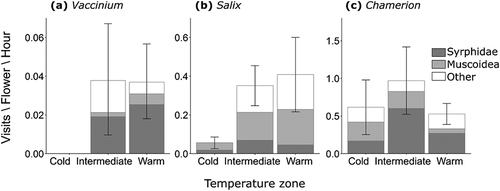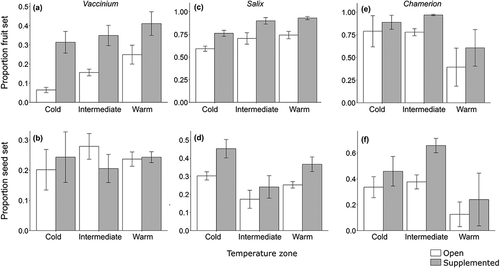Figures & data
Figure 1. Pollinator visitation rate in three temperature zones for (A) Vaccinium uliginosum, (B) Salix gluaca, and (C) Chamerion latifolium. The shades within the bars represent different groups of visiting insects: Syrphidae (dark gray), Muscoidea (families Anthomyiidae and Muscidae; light gray), and other insects (white). The height of the bars represents mean visitation rate ± 1 SE across all insects. Note the different scales on the y axes

Figure 2. Conspecific stigma pollen receipt in three temperature zones for (A) Vaccinium uliginsoum pollen tetrads and (B) Chamerion latifolium pollen grains. Bars represent mean values ± 1 SE. Different letters indicate significant differences among treatments according to Tukey’s test at the 0.05 significance level. Note the different scales on the y axes

Figure 3. Proportion fruit set in outcrossed pollination and self-pollination treatments for (A) Vaccinium uliginosum and (B) Chamerion latifolium. Bars represent mean proportion fruit set ± 1 SE. Note the different scales on the y axes

Figure 4. Plant reproduction, measured as proportion fruit set and proportion seed set for (A, B) Vaccinium uliginosum, (C.D) Salix glauca, and (E, F) Chamerion latifolium. Plant reproduction was measured across three temperature zones and two experimental treatments: open pollinated (white bars) and hand-pollinated with supplemental pollen (gray bars). Bars represent mean ± 1 SE. Note the different scales on the y axes

